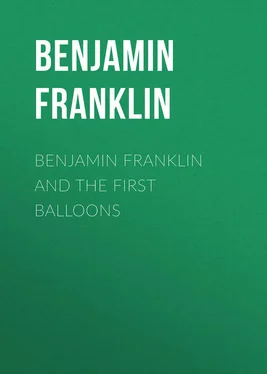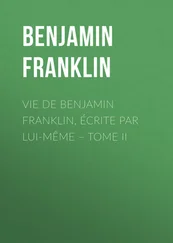Benjamin Franklin - Benjamin Franklin and the First Balloons
Здесь есть возможность читать онлайн «Benjamin Franklin - Benjamin Franklin and the First Balloons» — ознакомительный отрывок электронной книги совершенно бесплатно, а после прочтения отрывка купить полную версию. В некоторых случаях можно слушать аудио, скачать через торрент в формате fb2 и присутствует краткое содержание. Жанр: foreign_antique, foreign_prose, на английском языке. Описание произведения, (предисловие) а так же отзывы посетителей доступны на портале библиотеки ЛибКат.
- Название:Benjamin Franklin and the First Balloons
- Автор:
- Жанр:
- Год:неизвестен
- ISBN:нет данных
- Рейтинг книги:3 / 5. Голосов: 1
-
Избранное:Добавить в избранное
- Отзывы:
-
Ваша оценка:
- 60
- 1
- 2
- 3
- 4
- 5
Benjamin Franklin and the First Balloons: краткое содержание, описание и аннотация
Предлагаем к чтению аннотацию, описание, краткое содержание или предисловие (зависит от того, что написал сам автор книги «Benjamin Franklin and the First Balloons»). Если вы не нашли необходимую информацию о книге — напишите в комментариях, мы постараемся отыскать её.
Benjamin Franklin and the First Balloons — читать онлайн ознакомительный отрывок
Ниже представлен текст книги, разбитый по страницам. Система сохранения места последней прочитанной страницы, позволяет с удобством читать онлайн бесплатно книгу «Benjamin Franklin and the First Balloons», без необходимости каждый раз заново искать на чём Вы остановились. Поставьте закладку, и сможете в любой момент перейти на страницу, на которой закончили чтение.
Интервал:
Закладка:
Abbott Lawrence Rotch, Benjamin Franklin
Benjamin Franklin and the First Balloons
BENJAMIN FRANKLIN AND THE FIRST BALLOONS
The recent bi-centenary of Franklin’s birth, which coincided with the revival of interest in balloons, makes this a timely topic, especially since Franklin’s descriptions of the first balloon ascensions are almost unknown and do not appear among his philosophical papers. The five letters which I have the honor to present were written to Sir Joseph Banks, President of the Royal Society of London, in 1783, when Franklin was Minister to the Court of France and, with the collateral documents, they give perhaps the most complete and accurate account of the beginning of aerial navigation, enlivened with the humor and speculation characteristic of the writer. It is certainly remarkable that Franklin, in the midst of diplomatic and social duties, could have found time to investigate personally this new invention of which he at once appreciated the possibilities.
The documents which I publish are copies of Franklin’s letters, made on thin paper in a copying press (probably the rotary machine invented by Franklin), and all but one bear his signature in ink. They have corrections in the author’s hand-writing and, except for a few words, are quite legible. They were purchased by me from Dodd, Mead & Co., in December, 1905, and previously had belonged to G. M. Williamson, of Grandview-on-the-Hudson, to whom they had come from Vienna. None of the letters appear in Sparks’ edition of Franklin’s Works, and while all but one are included in the collections compiled by Bigelow and Smyth, there are numerous inaccuracies, some of which will be specified hereafter. Drafts of three of the letters are deposited in the University of Pennsylvania, but the existence of one letter and the whereabouts of another were unknown to the late Mr. Smyth, the editor of the last and most complete edition of Franklin’s Works, 1 1 The Writings of Benjamin Franklin, collected and edited by Albert Henry Smyth, Volume IX, New York, 1906.
who made careful search for the original documents. Although the American owners of these copies did not allow them to be transcribed, Mr. Smyth states that he printed one letter from my copy, and he noted how the other copies differed from the drafts in the University of Pennsylvania. In general it may be said that, whereas Bigelow gives the text without paragraphs, capital letters or the old spelling, 2 2 Complete Works of Benjamin Franklin, compiled and edited by John Bigelow, Volume VIII, New York, 1888.
Smyth follows the originals more closely. In view of the historic and scientific interest of these letters, they are now printed exactly according to the press-copies. The letter dated November 30, appears never to have been printed and whereas Smyth reproduced the letter of November 21 from the University of Pennsylvania draft, this or another draft (or possibly this copy) was in the possession of the French aeronaut, Gaston Tissandier, about 1887. 3 3 Histoire des Ballons, Paris, 1887, Volume I, page 29.
(THE FIRST HYDROGEN BALLOON.)
Sir,
On Wednesday, the 27th Instant the new aerostatic Experiment, invented by Messrs. Montgolfier, of Annonay, was repeated by M. Charles, Professor of experimental Philosophy at Paris.
A hollow Globe 12 feet Diameter was formed of what is called in England Oiled Silk, here Taffetas gommé , the Silk being impregnated with a Solution of Gum elastic in Lintseed Oil, as is said. The Parts were sewed together while wet with the Gum, and some of it was afterwards passed over the Seams, to render it as tight as possible.
It was afterwards filled with the inflammable Air that is produced by pouring Oil of Vitriol upon Filings of Iron, when it was found to have a tendency upwards so strong as to be capable of lifting a Weight of 39 Pounds, exclusive of its own Weight which was 25 lbs. and the Weight of the Air contain’d.
It was brought early in the morning to the Champ de Mars , a Field in which Reviews are sometimes made, lying between the Military School and the River. There it was held down by a Cord till 5 in the afternoon, when it was to be let loose. Care was taken before the Hour to replace what Portion had been lost, of the inflammable Air, or of its Force, by injecting more.
It is supposed that not less than 50,000 People were assembled to see the Experiment. The Champ de Mars being surrounded by Multitudes, and vast Numbers on the opposite Side of the River.
At 5 aClock Notice was given to the Spectators by the Firing of two Cannon, that the Cord was about to be cut. And presently the Globe was seen to rise, and that as fast as a Body of 12 feet Diameter, with a force only of 39 Pounds, could be suppos’d to move the resisting Air out of its Way. There was some Wind, but not very strong. A little Rain had wet it, so that it shone, and made an agreeable Appearance. It diminished in Apparent Magnitude as it rose, till it enter’d the Clouds, when it seem’d to me scarce bigger than an Orange, and soon after became invisible, the Clouds concealing it.
The Multitude separated, all well satisfied and delighted with the Success of the Experiment, and amusing one another with discourses of the various uses it may possibly be apply’d to, among which many were very extravagant. But possibly it may pave the Way to some Discoveries in Natural Philosophy of which at present we have no Conception.
A Note secur’d from the Weather had been affix’d to the Globe, signifying the Time & Place of its Departure, and praying those who might happen to find it, to send an account of its State to certain Persons at Paris. No News was heard of it till the next Day, when Information was receiv’d, that it fell a little after 6 aClock, at Gonesse, a Place about 4 Leagues Distance, and that it was rent open, and some say had Ice in it. It is suppos’d to have burst by the Elasticity of the contain’d Air when no longer compress’d by so heavy an Atmosphere.
One of 38 feet Diameter is preparing by Mr. Montgolfier himself, at the Expence of the Academy, which is to go up in a few Days. I am told it is constructed of Linen & Paper, and is to be filled with a different Air, not yet made Public, but cheaper than that produc’d by the Oil of Vitriol, of which 200 Paris Pints were consum’d in filling the other.
It is said that for some Days after its being filled, the Ball was found to lose an eighth Part of its Force of Levity in 24 Hours; Whether this was from Imperfection in the Tightness of the Ball, or a Change in the Nature of the Air, Experiments may easily discover.
I thought it my Duty, Sir, to send an early Account of this extraordinary Fact, to the Society which does me the honour to reckon me among its Members; and I will endeavour to make it more perfect, as I receive farther Information.
With great Respect, I am, Sir, Your most obedient and most humble Servant B. FRANKLINSir Joseph Banks, Bart.
P. S. Since writing the above, I am favour’d with your kind Letter of the 25th. I am much obliged to you for the Care you have taken to forward the Transactions, as well as to the Council for so readily ordering them on Application. Please to accept and present my Thanks.
I just now learn, that some observers say, the Ball was 150 Seconds in rising, from the Cutting of the Cord till hid in the Clouds; that its height was then about 500 Toises, but, being moved out of the Perpendicular by the Wind, it had made a Slant so as to form a Triangle, whose Base on the Earth was about 200 Toises. It is said the Country People who saw it fall were frightned, conceiv’d from its bounding a little, when it touched the Ground, that there was some living Animal in it, and attack’d it with Stones and Knives, so that it was much mangled; but it is now brought to Town and will be repaired.
Читать дальшеИнтервал:
Закладка:
Похожие книги на «Benjamin Franklin and the First Balloons»
Представляем Вашему вниманию похожие книги на «Benjamin Franklin and the First Balloons» списком для выбора. Мы отобрали схожую по названию и смыслу литературу в надежде предоставить читателям больше вариантов отыскать новые, интересные, ещё непрочитанные произведения.
Обсуждение, отзывы о книге «Benjamin Franklin and the First Balloons» и просто собственные мнения читателей. Оставьте ваши комментарии, напишите, что Вы думаете о произведении, его смысле или главных героях. Укажите что конкретно понравилось, а что нет, и почему Вы так считаете.









![Benjamin Franklin - Memoirs of Benjamin Franklin; Written by Himself. [Vol. 2 of 2]](/books/747975/benjamin-franklin-memoirs-of-benjamin-franklin-wr-thumb.webp)
